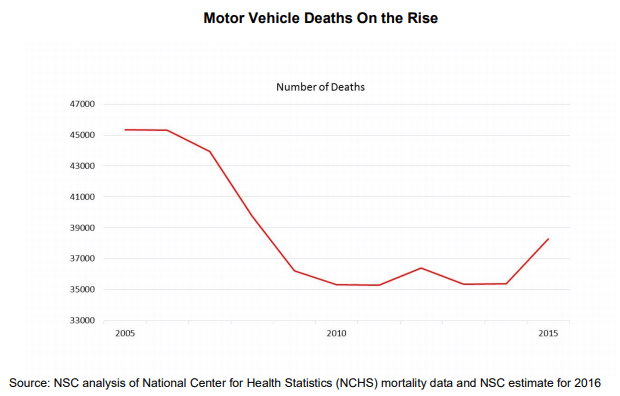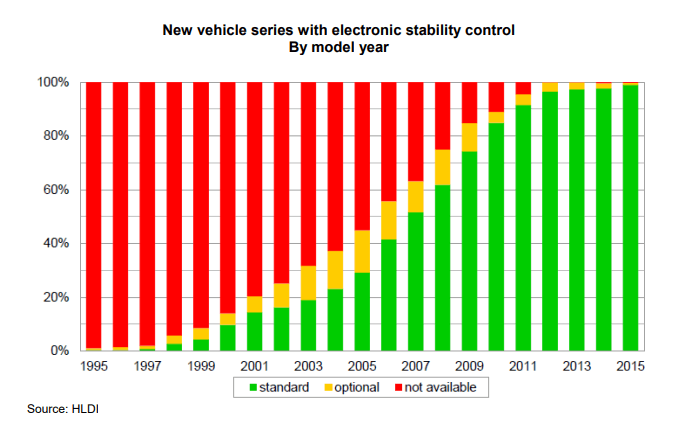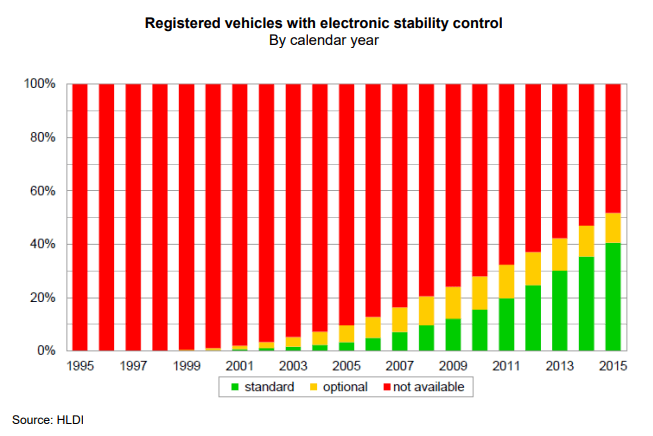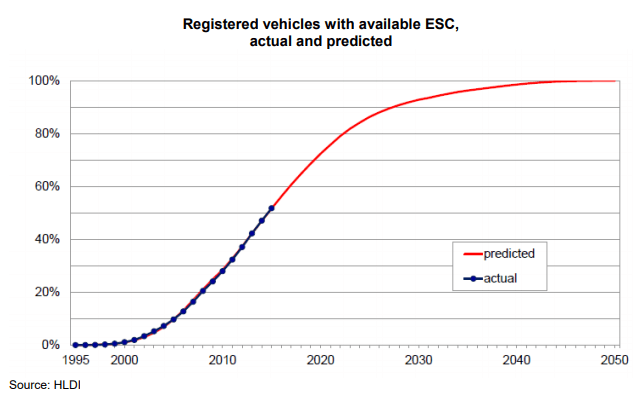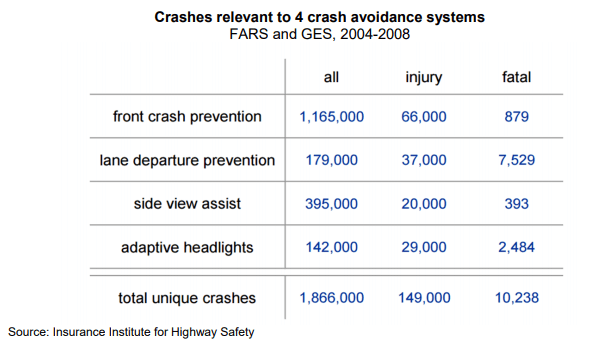Similar conclusions were reached in a July 2016, Carnegie Mellon study which stated that just three technologies—forward collision warning, lane departure warning and blind spot monitoring—could have prevented or reduced as many as 1.3 million crashes annually and over 10,000 fatal crashes. This study further found that almost one quarter of all crashes could be affected by these crash avoidance systems, but only 2% of 2013 model year cars included these systems as standard.
While many of these technologies are available on higher value cars or as part of an upgraded technology package today, they are not standard equipment on all makes and models. Safety should not be just for those who can afford it, especially for technologies that will result in thousands of lives saved every year. The Carnegie Mellon study estimated that if all light-duty vehicles were equipped with the three technologies, they would provide a lower bound annual benefit of about $18 billion. With 2015 pricing, it would cost about $13 billion to equip all lightduty vehicles with the three technologies, resulting in an annual net benefit of about $4 billion or a $20 per vehicle net benefit. By assuming all relevant crashes are avoided, the total upper bound annual net benefit from all three technologies combined is about $202 billion or an $861 per vehicle net benefit, at current technology costs.
NSC recognizes and applauds the voluntary commitment made earlier this year by 20 automakers to include automatic emergency braking (AEB) on all vehicles sold in the US by 2022. Toyota has already committed to beat this date by several years. Given the slow turnover of the fleet, we encourage other manufacturers to view the 2022 date as a finish line rather than a starting point and accelerate the roll out of AEB and other lifesaving technologies.
Whether mandated or optional, in many cases these systems can perform driving tasks more predictably, more conservatively and more safely than a human driver, and may act without driver input if a driver is distracted, impaired or incapacitated. However, because there are no minimum standards for many of these technologies, legitimate questions about their effectiveness remain. The line between ADAS and highly automated vehicles may be blurred, as we have progressed far down the path of advanced features with few questions and widespread acceptance of semi-automated features.
Dedicated Short Range Communication (DSRC)
Another component of ADAS and automated vehicle systems is dedicated short range communication (DSRC), which would allow vehicles to communicate over dedicated spectrum bands with each other, pedestrians, and infrastructure to prevent collisions. This technology, often referred to as V2V (vehicle-to-vehicle), V2I (vehicle-to-infrastructure), V2P (vehicle-topedestrian), or V2X (vehicle-to-everything), is pending a rulemaking decision by NHTSA to establish performance standards. NSC encourages NHTSA to release this standard soon so that implementation of V2X can be more widespread.
DSRC can create redundant safety systems in motor vehicles. In other modes of transportation, fail-safe designs can support operator error, but in highway vehicles that task has fallen solely on drivers. DSRC would allow a vehicle to communicate with a red light to compensate for a fatigued driver, stop a car to prevent a collision with a pedestrian if a driver fails to detect him or her, and prevent or mitigate collisions between vehicles equipped with DSRC. DSRC has been deployed by some manufacturers, but NSC believes it is an important option in a safe systems approach to the design of HAVs and anticipates it will be more widely deployed if there is more regulatory certainty.
Education and Training
One component in the AV policy that should be a requirement moving forward is the incorporation of driver education and training about new safety technologies. With nearly 17.4 million new passenger cars and trucks sold in 2015, understanding the technology on these vehicles is necessary, yet a University of Iowa survey found that 40 percent of respondents reported they had experienced a situation in which their vehicle acted in an unexpected way. When this occurs in a real-life driving situation, among multiple drivers, it can lead to disastrous outcomes.
The National Safety Council and our research partners at the University of Iowa are focused on educating consumers about in-vehicle safety technology through our MyCarDoesWhat campaign. This brand agnostic education campaign informs drivers about how safety technologies work, how to best interact with them, and how to identify situations when the technology may not perform optimally and should not be relied upon. Because of the need for continued human involvement in the operation of many of these features, the campaign tagline is You are your car’s best safety feature.
Visitors to MyCarDoesWhat.org realize improvement in general knowledge and accurate comprehension of vehicle safety features. Drivers cannot effectively use these life-saving technologies if they do not understand both their functions and limitations. The AV policy proposes that this education be delivered in multiple ways, including computer based, hands-on and virtual reality training, and other innovative approaches. The MyCarDoesWhat education campaign follows that approach, and is developing virtual reality modules for release early next year. Further, we recommend ongoing evaluation to determine the effectiveness of the various messages, methods of delivery and media so they can be improved over time.
Standardized Nomenclature and Performance Outcomes
Another way to reduce consumer confusion is to standardize the nomenclature or taxonomy for advanced technologies. NSC, the State of California, and Consumer Reports have recommended that, at the very least, systems that are not completely automated or Level 5 should not be described as such. ADAS, with emphasis on driver assist, represents the vehicles being sold today and requires drivers to remain fully engaged in the driving task. That fact is often lost in marketing, media reports and consumer expectations. Labeling a motor vehicle as “autonomous” today, or even using terms such as “autopilot”, only confuses consumers and can contribute to losses of situational awareness around the driving task.
By establishing standard nomenclature and establishing clear performance outcomes, consumers will better understand what they should expect from these technologies. For example, vehicles marketed as having AEB will not necessarily come to a complete stop before a collision. 15 Some AEB systems only operate at higher speeds, and some are designed to slow rather than stop prior to a collision. These nuances may not be easily understood by consumers. IIHS reports that systems with a warning only, but no automatic corrective action, reduce frontal crash rates by about 25%, but vehicles with automatic braking reduce crashes by more than 40%. Vehicles with a warning and automatic braking reduce crash rates by about 50%. Establishing a standardized, results-based, understandable definition of AEB and other ADAS technologies would benefit consumers, manufacturers, and dealers, as well as organizations that evaluate vehicles for their safety benefits.
Finally, the New Car Assessment Program (NCAP) program has operated for nearly 40 years with a goal of testing vehicle safety systems and educating consumers about them. Practically, it has created a mechanism to allow consumers to evaluate vehicles on safety systems. NSC supports NCAP and believes it is an important program to improve the safety of the motor vehicle fleet. Standardized nomenclature and performance outcomes will ensure NCAP can more effectively compare vehicle safety systems between manufacturers, and even between a manufacturer’s own models.
Data Protection and Sharing
The National Safety Council is very bullish on ADAS, and eventually fully automated vehicles, because we know when implemented safely and properly, they will help us realize huge gains in reducing roadway fatalities. But a minimum requirement, if we are to realize the life-saving benefits, will be ensuring that we have reliable event data recorders that produce data in a standardized format that is downloadable for investigators, law enforcement, state highway safety offices, insurers and other relevant stakeholders. Following a crash, we must be able to answer simple questions like whether the vehicle systems or the human driver had control of the car, if and how the vehicle was communicating with the driver, and if all systems were working as designed.
The AV policy details the importance of data collection as these technologies begin to be tested in real-world scenarios. Understanding the circumstances and causes surrounding malfunctions, including at lower levels of automation, will help make this technology stronger and safer, and ensure failures are less likely to occur as technology evolves. This will be especially important in assuring consumers of the reliability of ADAS and automated technology. As the former Chairman of the NTSB, I believe that minimum parameters should be set for data preservation, standardization of formats, ease of access for post-crash evaluation, and establishment of privacy protections early in the process. Data-sharing programs require greater maturity and a strong safety culture committed to continuous improvement.
Event data recorders (EDRs) are widely used throughout the automotive industry in vehicles of all shapes and sizes, yielding valuable data in crash reconstruction efforts. Similar devices are used in other modes of transportation as well. Amtrak utilizes event data recorders that automatically transmit data from locomotive recorders to a control center when an event occurs. In the aviation industry, crash-hardened “black box” data recorders store thousands of parameters of data. Much of this information is collected after normal flights and analyzed by the operator to learn about and improve operations, and in the case of an incident, the data is invaluable to investigators to determine what occurred. The same could be true for motor vehicles.
Missing from the policy, however, is clarification on whether lower-level systems (below Level 3) should be subject to the same data collection guidelines. The current event data recorder standards do not require the majority of Levels 1 and 2 safety systems’ sensors be tracked.16 This lack of information limits real world data availability that could guide the future development of these technologies to make them safer. Currently, there is no easy way for manufacturers, law enforcement, investigators or vehicle owners to understand whether deployed systems were active during a crash, whether they malfunctioned, or whether they helped mitigate damage or injury or returned the car to a safe state in event of a malfunction.
Information sharing is included in the AV policy. However, the policy fails to mention the public health argument for collecting data from electronic devices in the car in the event of a crash. Acquiring an understanding of what happens when systems perform as intended, fail as expected, or fail in unexpected ways will yield valuable information for manufacturers–some of whom have common suppliers. Further, in-service data, as well as near miss and post-crash information sharing, can help civil engineers and planners design better and safer roadways, as well as help safety and health professionals design better interventions to discourage risky driving or affect the behaviors of other roadway users.
De-identified data sharing has been in existence in the aviation industry for many years and proven highly successful. The Aviation Safety Information Analysis and Sharing (ASIAS) system allows for sharing of de-identified data across the aviation industry, making it possible for the industry to identify trends and act on them. Analysis of de-identified data will provide windows in to leading indicators in the motor vehicle industry. Leading indicators are “proactive, preventative and predictive measures that monitor and provide current information about the effective performance, activities and processes of a … system that drive the identification and eliminate or control of risks.” The NSC Campbell Institute, a leader in workplace safety, health and sustainability, states that tracking leading indicators allows world-class safety organizations to make further improvements to their safety records.
The AV policy also suggests that auto manufacturers use EDRs to gain a better understanding of how human operators engage with advanced technology. This knowledge will allow manufacturers to be nimbler and make adjustments in near real time for some systems based on what is actually occurring in the driver’s seat, rather than making changes based on assumptions and estimations that must be accommodated in a later model year. Collecting and sharing de-identified data about near misses and other relevant problems could also help by aggregating useful information for the automotive industry, allowing them to take proactive steps based on leading indicators rather than waiting for a crash or a series of crashes to occur. Finally, this data would be useful to researchers and the safety community in analyzing the safety benefits–and potential drawbacks–of these technologies as they continue to mature.
While there are competing priorities regarding protecting personal privacy and proprietary systems or designs, NSC believes that safety should be the ultimate priority, and that other concerns need to be accommodated to prioritize safety. NHTSA should facilitate data sharing as widely as possible and require that manufacturers provide accessible, standardized data to law enforcement, state highway safety offices, investigators, insurers, and/or other relevant stakeholders.
American National Standards Institute (ANSI) Standard
As important as it is for the average consumer to know and understand the ADAS and automated technology, there is also work to be done on this issue as it relates to the technology and its rollout to commercial fleets. As such, NSC is taking a leading role working with the American Society of Safety Engineers (ASSE) and a wide array of experts in the automotive industry, technology sector, academia and fleet management, to develop an ANSI standard to address policies, procedures and management processes that will assist in the control of risks and exposures associated with the operation of autonomous fleet vehicles on public thoroughfares.
NHTSA Resources and Oversight in the Midst of Changing Technology
In response to reports of repeated incidents of unintended acceleration in Toyota vehicles in 2009-2010, the National Research Council Transportation Research Board conducted an investigation into whether NHTSA had reached the correct conclusion in its own investigation, as well as to produce advice on how to best handle future issues involving the safe performance of vehicle electronics. This research resulted in a report, released on January 18, 2012.
The Research Council found that while NHTSA’s decision to close its investigation was justified, it was “troubling that NHTSA could not convincingly address public concerns about the safety of automotive electronics.” More specifically, the Research Council stated that “to respond effectively and confidently to claims of defects in the more complex electronic systems… NHTSA will require additional specialized technical expertise.” While they acknowledged it was unrealistic to expect NHTSA to hire and maintain these specialized personnel in a constantly evolving field, they made a specific recommendation that NHTSA establish a standing technical advisory panel with members representing a wide array of technical expertise central to the design, development, and safety assurance of automotive electronics systems.
With technology advancing as quickly as it is, it is difficult to keep up with advances without appropriate resources. Last year, NSC supported the administration’s NHTSA funding request of $1.1813 billion, which included $200 million for the Autonomous Vehicle Development program. We encourage this Committee and Congress to fully fund NHTSA, including requested investments in programs that will support the development of ADAS and HAVs. We also recommend that NHTSA consider how to best take advantage of existing knowledge by establishing an advisory committee or similar mechanism to engage experts in the field of advanced technology and automotive electronic systems.
Road to Zero
On October 5, NSC, NHSTA, the Federal Highway Administration (FHWA), and the Federal Motor Carrier Safety Administration (FMCSA) announced the Road to Zero (RTZ) Coalition. RTZ is a partnership initiative focused on dramatic reductions in roadway fatalities. Over 80 public and private organizations attended the announcement to learn more about committing to a shared vision of zero fatalities on our roadways. The first meeting of the coalition will be on December 15.
The purpose of the Road to Zero Coalition is to 1) encourage and facilitate widespread implementation of countermeasures to reduce motor vehicle crash deaths in the near term; 2) develop a scenario-based vision for zero US traffic deaths in the future; and 3) provide a roadmap for policymakers and stakeholders to eliminate traffic deaths.
NSC is joined on the Steering Group for the Road to Zero Coalition by the following organizations: Advocates for Highway and Auto Safety, American Association of Motor Vehicle Administrators (AAMVA), American Association of State Highway and Transportation Officials (AASHTO), Commercial Vehicle Safety Alliance (CVSA), Governors Highway Safety Association (GHSA), Institute of Transportation Engineers (ITE), Insurance Institute for Highway Safety (IIHS), Intelligent Car Coalition, International Association of Chiefs of Police (IACP), Mothers Against Drunk Driving (MADD), National Association of State Emergency Medical Services Officials (NASEMSO), National Association of City Transportation Officials (NACTO), National Association of County Engineers (NACE), and the Vision Zero Network.
On behalf of the Coalition, the NSC will administer a grant program to support national nonprofit organizations committed to roadway safety programs that address the overlaps and gaps between roadway users, vehicles and infrastructure. In addition, the Coalition will look at engaging others in near term solutions and countermeasures to reduce the death toll on our roadways. Finally, we will also provide critical input for the development of a future community scenario with zero traffic fatalities–an effort to look at the measures, programs and technologies will be necessary to reach zero highway fatalities in thirty years and work back from there. NHTSA, FHWA, FMCSA, and NSC are sponsoring the development of the scenario-based vision for zero traffic deaths in the U.S. in a 30-year timeframe, and the RAND Corporation has been retained to produce the scenario over the next 12-18 months. I look forward to briefing this Committee and others in Congress on the results of these activities and the efforts of the Coalition to reach zero deaths on our roadways.
Conclusion
Today, we have millions of drivers behind the wheel, spend millions of dollars on education and enforcement campaigns, and still recognize billions in economic loses as a result of crashes. In spite of safer vehicle designs and record-setting seat belt use rates across the nation, operating a motor vehicle remains one of the deadliest things we do on a daily basis.
NSC believes fully automated vehicles have the potential to save lives and prevent injuries, but– as outlined above–there are several key issues that policymakers must address. The AV policy begins this discussion, and we applaud NHTSA and DOT for issuing it.
It will be a long time before HAVs replace our current fleet. The transition will likely be messy as we deal with a complex and ever-changing Human-Machine interface. There will be an evolution of the existing technologies and perhaps a revolution when it comes to new and different technologies. We need to be prepared for unanticipated consequences and new failure modes.
Although we can imagine a future with automated vehicles, it will be a long and winding road to get to the destination of zero fatalities as a result of HAVs. We cannot afford to ignore the carnage on our highways that is a national epidemic today. The US trails other industrialized countries in addressing highway deaths. Efforts like Road to Zero will decrease fatalities today, tomorrow, and in the future if we embrace proven countermeasures and accelerate deployment of effective ADAS technologies.
NSC appreciates this Committee’s leadership on vehicle technology and safe roadway transportation. If safety for the traveling public is the ultimate goal, advanced technology provides the most promising opportunity to achieve that outcome, and will go a long way toward reaching the goal of eliminating preventable deaths in our lifetime.

